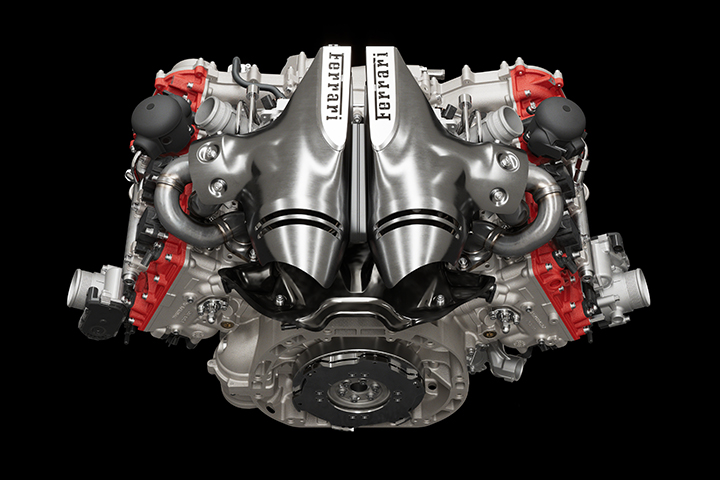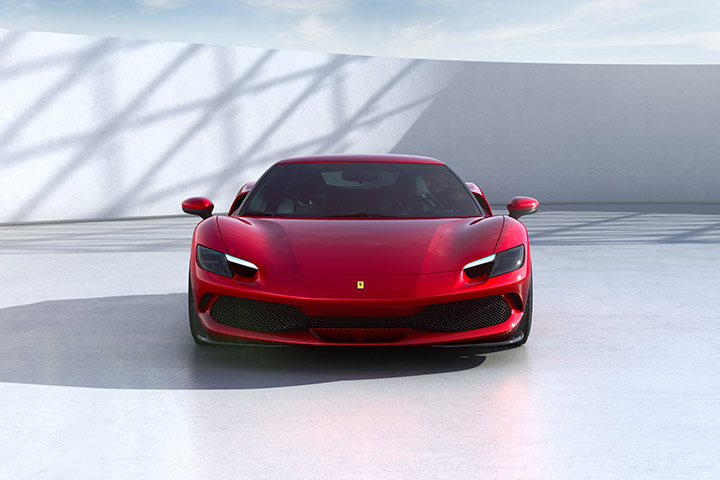296 GTB
Fuel consumption, weighted combined: 8.3 l/100 km
Electric consumption, weighted combined: 8.1 kWh/100 km
Charge-depleting fuel consumption, combined: 10.7 l/100 km
CO2 emissions, combined: 201 g/km
CO2 classes, based on the weighted combined CO2-emissions AND based on the combined CO2-emissions: G, G
Defining fun to drive
- TypeV6 – 120°
- Overall displacement 2992 cm3
- Bore and stroke88 mm x 82 mm
- Max. power output ICE*663 cv
- Max. power output hybrid system**610 kW (830 cv) at 8000 rpm
- Max. torque740 Nm at 6250 rpm
- Max. revs8500 rpm
- Compression ratio9.4:1
- High voltage battery capacity7.45 kWh
- * With 98 RON petrol
- ** with eManettino in Qualify mode
- Length4565 mm
- Width1958 mm
- Height1187 mm
- Wheelbase2600 mm
- Front Track1665 mm
- Rear track1632 mm
- Dry weight***1470 kg
- Dry weight/power ratio1.77 kg/cv
- Weight distribution40.5 % front / 59.5 % rear
- Fuel tank capacity65 litres
- *** With optional lightweight content
- Tyres - Front245/35 ZR 20 J9.0
- Tyres - Rear305/35 ZR 20 J11.0
- Brakes - Front 398 x 223 x 38 mm
- Brakes - Rear360 x 233 x 32 mm
- 8-speed F1 DCT
- eSSC: eTC, eDiff, SCM, FDE2.0, EPS, ABS Evo, 6w-CDS; high-performance ABS/EBD with energy recovery
- Max. speed> 330 km/h
- 0-100 km/h2.9 s
- 0-200 km/h7.3 s
- 200-0 km/h107 m
- Fiorano lap time1’ 21”
- Fuel consumption, weighted combined8.3 l/100 km
- Electric consumption, weighted combined8.1 kWh/100 km
- Charge-depleting fuel consumption, combined10.7 l/100 km
- CO2 emissions, combined201 g/km
- CO2 classes, based on the weighted combined CO2-emissions AND based on the combined CO2-emissionsG, G
The 296 GTB is the first Prancing Horse road car to feature a 120° V6 turbo engine.

Its structure means that the turbochargers can fit within the “V”. This helps it achieve extraordinarily high power levels (663 hp). The Ferrari V6 also sets a record of 221 hp/l for specific torque output for a production car. This architecture is rooted in the Prancing Horse's incomparable racing experience: the first Ferrari to fit a mid-rear V6 was the 246 SP in 1961, which won the Targa Florio that year and in 1962. Also, in 1961, Ferrari claimed its first Formula 1 Constructors' title with the 156 F1 powered by a 120° V6. Ferrari installed mid-mounted turbos on the 126 CK and then on the 126 C2, which in 1982 became the first turbocharged single-seater to win the Formula 1 World Championship. The triumphant 126 C3 followed hot on its tails in 1983. Finally, the V6 PHEV turbo architecture has been shared by all Formula 1 cars since 2014.

The 296 GTB breaks into the sports berlinetta segment with radical and innovative choices. The turbocharger in the “V” of the crankcase improves thermal management of the engine compartment and electrical components. On the 296 GTB, an active aerodynamic device at the rear aims to generate additional downforce.
The aerodynamics of the 296 GTB provides 10% more downforce than previously in LD (Low Drag) configuration, with a further 100 kg added thanks to the active HD (High Downforce) spoiler. What this means in practice is unprecedented handling, braking performance and driving excitement.
Advanced control functions

The design of the 296 GTB redefines the identity of Ferrari's mid-rear-engined berlinetta, giving the car a compact, modern and original line. Its short wheelbase and monolithic appearance make it the most compact berlinetta from Maranello of the last decade. Having abandoned the typical fastback berlinetta layout, the Ferrari Style Centre focused on creating a cabin set within a powerful volume. The car has a unique identity, which rewrites the rules while rediscovering the authentic principles of Italian design: formal cleanliness and clear-cut lines enhance the sportiness of this worthy heir to a philosophy deeply rooted in Ferrari tradition. Its modernity refers back to cars of the sixties with their simplicity and functionality, including the 1963 250 LM, which provided notable elements of inspiration such as the cut of the “B” pillar, the rear mudguard and the truncated tail.

The cabin is built around the full-digital interface introduced on the SF90 Stradale, and it is its visual congruity with the latter that defines the shapes of its fittings. However, on the 296 GTB, the aim was to assimilate the technical content into a refined look. The result is pure and characterized by considerable elegance. Most of the instruments are concentrated on the driver's side. The cockpit is created from a break in the dashboard from which the steering wheel and instrument panel emerge. The passenger area has a minimalist look; the display offers the chance to participate in the journey, almost like a co-driver.
Customers wishing to make the most of the car's dynamic characteristics, especially during track days, can select the 296 GTB in the exclusive Assetto Fiorano set-up, achieving performance improvements thanks to its aerodynamics and weight reduction. These include Multimatic dampers derived from GT racing, carbon fiber aids on the front bumper, and the use of lightweight materials such as carbon fiber. The structure of some components has been totally redesigned to save more than 12 kg. Also available, only for the Assetto Fiorano set-up, is the ultra-light rear screen in Lexan® and a livery inspired by the 250 LM. This starts with the front bumper, whose background embraces the central grill and outlines its contours, continuing first on the bonnet and then longitudinally up to the roof and rear spoiler.

DISCOVER THE FERRARI 296 GTB MODEL AVAILABLE FOR SALE AT Maranello Motors GmbH
Maranello Motors GmbH
- Opening hours
- mon - fri09:00 - 18:00
- sat10:00 - 13:00
- sunClosed

- Overview
- Technical Details
- ENGINE
- Aerodynamics
- Vehicle Dynamics
- Design
- Interior
- Assetto Fiorano set-up
- SMART GUIDE
- Contacts



